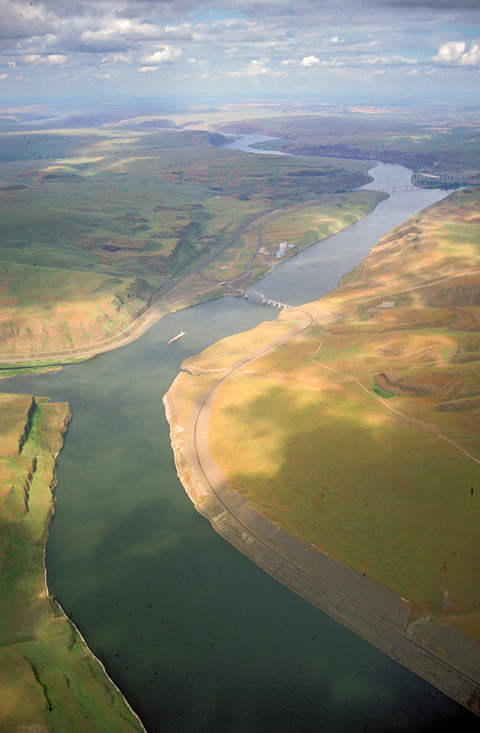Late in the “windey dark raney morning” of 13 October 1805, traveling down the Snake River—Clark had named it “Lewis’s”—which flows from bottom to top in the center of this photograph, the Corps passed the mouth of the Tucannon River, which they called “Ki-moo-ee-nimm Creek,” shown at left center in this view.
The river entering from the right, near the top of the photo, is the Palouse River (which Lewis and Clark named “Drewyer’s [Drouillard’s] River”). The lower Snake River today consists mainly of a chain of four relatively placid lakes between Lewiston, Idaho, and its confluence with the Columbia near the tri-cities of Pasco-Kennewick-Richland, Washington. The lakes are impounded by four dams. Pictured is Lake Herbert G. West, impounded by the Lower Monumental Dam, twenty miles downstream. Its upper end is at Little Goose Dam, eight miles upstream (below the photo) from the Tucannon.
In contrast, the Snake River as Lewis and Clark experienced it consisted of an almost continuous series of rapids. By the time they reached the Tucannon, the explorers had already made it through two very bad stretches, with “rocks in every derection.” Now they entered a four-mile-long torrent, its climax a “narrows or narrow rapid” through which a channel 25 yards wide was confined between “rugid rocks” for a solid mile and a half. Private Whitehouse described the scene with his own terse analogy: The river there “ran as swift as a mill tale,” he said, a “mill tail” being the water that was released after turning a mill wheel. Clark described it in more practical terms and a larger context: “We Should make more portages,” he admitted, “if the Season was not So far advanced and time precious with us.”
The expedition had interacted with Indian people daily since setting out from Canoe Camp on the seventh, and some of them were especially friendly and helpful. On this day, two Indian men on horseback caught up with the Americans and indicated they wished to accompany them. The Corps had become steadily more aware of the value of Sacagawea‘s presence. “The wife of Shabono our interpetr we find reconciles all the Indians, as to our friendly intentions,” Clark testified.
From Discovering Lewis & Clark from the Air
Photography by Jim Wark
Text by Joseph Mussulman
Reproduced by permission of Mountain Press
Experience the Lewis and Clark Trail
The Lewis and Clark Trail Experience—our sister site at lewisandclark.travel—connects the world to people and places on the Lewis and Clark Trail.
Discover More
- The Lewis and Clark Expedition: Day by Day by Gary E. Moulton (University of Nebraska Press, 2018). The story in prose, 14 May 1804–23 September 1806.
- The Lewis and Clark Journals: An American Epic of Discovery (abridged) by Gary E. Moulton (University of Nebraska Press, 2003). Selected journal excerpts, 14 May 1804–23 September 1806.
- The Lewis and Clark Journals. by Gary E. Moulton (University of Nebraska Press, 1983–2001). The complete story in 13 volumes.


